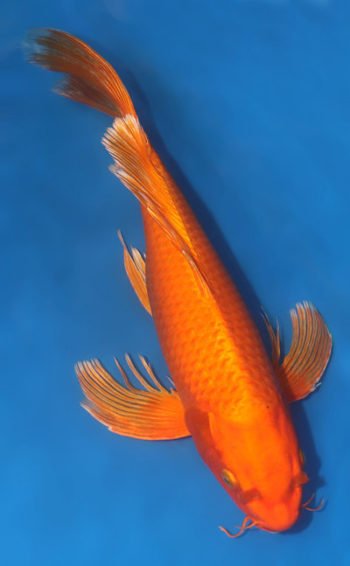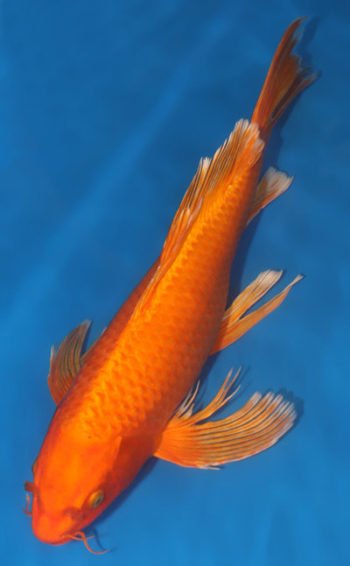Hirenaga Orange Ogon Koï
Voir tous nos poissons koi de haute qualité à vendre et nos poissons koi papillon à vendre. Nous offrons la meilleure sélection de koi à vendre dans l'industrie. Ajoutez à cela notre incroyable garantie d'arrivée en direct de 14 jours et la possibilité de choisir votre propre date de livraison et vous bénéficiez d'une valeur imbattable.
GARANTIE SANS SOUCIS DE 14 JOURS : Nous offrons un leader de l'industrie Garantie sans souci de 14 jours pour que vous puissiez magasiner en toute tranquillité d'esprit, sachant que vous serez toujours couvert.
Éleveur(s): Ferme paradisiaque d'Arowana
Sexe: Femelle
Taille: 18,47 pouces
Variété: Hirenaga, Hirenaga Orange Ogon
$160.00 Original price was: $160.00.$150.00Current price is: $150.00.
Description
Hirenaga Orange Ogon Koi For Sale
Hirenaga Orange Ogon Koi, there are so many names for this variety — hirenaga (“long fin”), onaga (“long tail”), tenaga (“long arm”) and hagoromo (“celestial robe of an angel”) are just a few. I like to use Hirenaga, because it is the most commonly used.
Unfortunately, Hirenaga did not gain much popularity in Japan. Instead, it became very popular overseas. In the United States, for example, there are Hirenaga divisions at koi shows, while there are none in Japan. I believe this stems from the different aesthetic senses of each culture. Because their fins are long, they are easy to split or tear. Personally, I think this imperfection might have bothered the Japanese eye.
However, I must admit that Hirenaga have made a very big contribution to the koi world. Because Hirenaga blood can be introduced to any variety, it literally doubles the varieties of Japanese koi.
Identification
Appreciation of Hirenaga is very simple. Though the long fin is its main characteristic, the shape and beauty of the fin is the most important part. After this has been identified, we can check the koi according to the standards of each variety.
When you look at the fins, ideally they should be long and symmetrical with no tears. Take a look at the examples in the pictures. Due to the high difficulty of breeding ideal, long fins, it should not be criticized too much. But I believe these examples should give you an idea of what to look for. After checking the shape of fins, the standards of each variety need to be checked. For example, koi A is a Tancho Sanke. So, we need to examine the shape of the circle on its head. The quality and location of the sumi are important in the Sanke variety.
Although Hirenaga are not popular in Japan, there are two excellent breeders in Niigata. If you consider the fact that more than 80 percent of Japanese Koi are exported, it seems natural that some breeders want to breed quality Hirenaga.
Koi Care Guide – Six choses à savoir sur votre koi
- Niveau d'expérience : Intermédiaire
- Taille : Koi grandir jusqu'à 36 pouces (91 cm) de long
- Durée de vie : Ils peuvent vivre plus de 50 ans et prospérer dans une large gamme de températures de l'eau
- Tempérament : Ils sont généralement paisibles mais peuvent s'attaquer aux poissons plus lents
- Origine : C'est un type de carpe originaire du Japon
- Le saviez-vous : Les koïs peuvent apprendre à reconnaître et à prendre la nourriture de leurs parents
Comment installer mon aquarium de koi ?
- Koi grandit rapidement et devient très gros. Gardez les koi matures dans un bassin extérieur d'au moins 3 pieds de profondeur, avec au moins 50 gallons d'eau par poisson.
- Les jeunes koi peuvent être gardés à l'intérieur dans un aquarium d'au moins 29 gallons.
- Placez l'aquarium dans un endroit calme à l'abri de la lumière directe du soleil et des courants d'air.
- Couvrez l'aquarium avec une hotte pour réduire l'évaporation et les éclaboussures et pour empêcher les poissons de sauter.
- Pour transférer de nouveaux koi dans l'aquarium, faites-les flotter dans l'eau à l'intérieur de leur sac pendant environ 10 minutes afin qu'ils puissent s'acclimater à la nouvelle température de l'eau.
- Si vous introduisez des koïs dans une école existante dans un aquarium ou un étang, mettez les nouveaux poissons en quarantaine dans un plan d'eau séparé pendant 2 à 4 semaines pour vous assurer qu'ils sont en bonne santé.
- Le jour du déménagement, utilisez un filet pour transférer les koïs afin que l'ancienne eau ne se mêle pas à l'eau nouvelle.
- Qu'ils vivent à l'intérieur ou à l'extérieur, n'ajoutez pas plus de 3 nouveaux koi à la fois.
Chaleur & lumière
Les koi d'extérieur sont robustes et hiberneront sous la glace en hiver tant que leur étang est suffisamment profond pour ne pas geler complètement. (Ils ne survivront pas dans la glace solide.)
L'étang de votre koi doit être partiellement ombragé.
Les koi d'intérieur préfèrent l'eau entre 65 et 75 degrés Fahrenheit.
Installez une lumière à l'intérieur d'un aquarium intérieur pour l'éclairer pendant 8 à 12 heures par jour.
La température de l'eau
Les koïs sont assez résistants à la température - ils peuvent même hiberner sous la glace en hiver. Assurez-vous simplement que votre étang a au moins un mètre de profondeur, sinon il pourrait geler et les koïs ne sont pas si coriaces. Lorsqu'ils vivent à l'intérieur, les koi préfèrent l'eau fraîche, entre 65 et 75 degrés F (18 et 24 C).
Comment garder mes koi en bonne santé ?
Si vos koïs d'extérieur ne semblent pas manger en hiver, ne vous inquiétez pas ; il est normal qu'ils arrêtent de manger à des températures inférieures à 40 F. Assurez-vous de contacter un vétérinaire si vous remarquez l'un de ces symptômes :
- Modèle de nage inhabituel
- Minceur ou diminution de l'appétit
- Gonflement abdominal
- Peau ou nageoires enflammées ou décolorées
- Ailerons serrés sur les côtés du corps
- Raclage du corps sur les rochers (clignotement)
types of koi fish, koi fish, koi fish price, koi fish pond, koi fish meaning, koi fish for sale, koi fish drawing, koi fish care, koi fish for sale online, butterfly koi for sale, koi fish for sale near me, big koi for sale, buy koi fish cheap, koi fry for sale usa, types of koi fish, koi fish for sale, High Quality Koi, Coy fish, coe fish, butterfly koi, types of koi, kodama koi, black koi, ogon koi, doitsu koi, tancho koi, butterfly koi varieties





Reviews
There are no reviews yet.